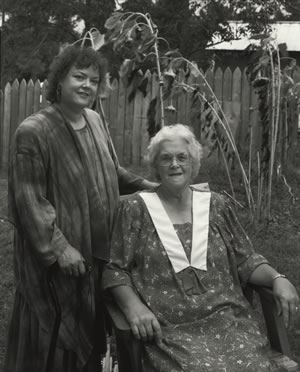Linda Stout
For the past fifteen years, Linda Stout’s mission has been to build multi-class and multi-racial social groups dedicated to bringing about change. Her work with the Piedmont Peace Project and the Peace Development Fund, on both local and national levels, relies on a non-traditional model. In front of a group of 30 textile mill workers, farmers, teachers, and domestic workers, Linda draws a triangle on the chalkboard. “This represents the hierarchical and traditional modes of leadership,” she explains pointing to the apex of the triangle. “But one person just doesn’t have all the answers.” Erasing the triangle, she draws a circle. “I prefer the circle as a model of leadership. The more people who become leaders, the stronger and more powerful the circle grows. Yes, everyone doesn’t have equal abilities but you need to bring them all into the circle, and hold one another accountable to specific tasks. Accountability and responsibility are crucial, but all members need to develop their leadership skills and perceive themselves as leaders.”
The daughter of a tenant farmer and a millworker, Linda grew up in the poverty of rural North Carolina. She remembers the humiliation as a child of being called “white trash.” “For so many years, the stigma of poverty made me feel that I was a bad person. I was convinced I wasn’t smart. I had a lot of anger and self-blame, and a lack of self-esteem too. I think the combination of being a thirteenth generation Quaker and living in poverty gave me a real sense of justice. I grew up believing that anger was OK if you looked for alternative options for change, options without violence.”
While Linda’s dream was to go to college and live in a house with running water, she could not raise the $500 needed to complement a scholarship she received. Instead of going to college, Linda worked in the office of a hosiery mill. There she was harassed by the Ku Klux Klan because she hired people of color. “That harassment led me to connect back into my Quaker roots of meetings and advocacy.” Septima Clark, a career civil rights leader, taught Linda about community organizing. In 1986, during a trip to Nicaragua to learn about international grassroots organizing, Linda noted how the Nicaraguans she met were “really proud of who they were and had a real understanding of how the political situation affected their poverty.” The experience altered her view of poverty. In 1985, she founded the Piedmont Peace Project (PPP), a North Carolina, multi-racial network of textile mill workers, farmers, and domestic workers. PPP members are uneducated, poor, and have been excluded from traditional leadership. Most PPP members are women; 70 percent are black.
Linda believes that those closest to problems often find the best solutions. Despite harassment and intimidation by the Ku Klux Klan, PPP has brought water and sewers into impoverished rural communities, registered 15,000 voters, advocated for the rights and working conditions of farmers, people of color, and the disabled. Hundreds of poor, rural North Carolinians have participated in the decision-making processes in their communities. In Midway, a black community in rural North Carolina, 80 percent of whose residents live on incomes below the poverty line, PPP helped local organizations secure a $600,000 community block grant and dramatically transform the town.
Linda has had to become “bilingual” in her work. In 1993, while a public policy fellow at Radcliffe College, Linda gave a talk about the PPP at the Harvard Law School. A law student stood up at the end of her talk and commented: “I learned a lot from your talk but you’d be more effective if you had the right grammar.” “In my community, I speak perfect grammar,” Linda says, “But in order to do this kind of work, you have to listen and talk to both sides and be a translator. That way you play a critical and important role of building bridges.” Linda “builds bridges” in three ways: by identifying and acknowledging the barriers of class, race, and gender; by understanding how oppression and privilege work; and by building alliances to change the barriers.
In 1997, Linda moved to building bridges at a national level when she became the director of the Peace Development Fund (PDF), a national foundation based in Amherst, Massachusetts, that provides funding and training for grassroots social-change groups.
Linda Stout grew up convinced she was unable to “do things” because she was poor. She remembers, “Years ago, when I first became involved with the movement, I said, ‘I’ll do everything except I won’t write and I won’t raise money.'” In 1997, Linda published a book, Bridging the Class Divide: And Other Lessons for Grassroots Organizing. She is responsible for a $1 million budget. And not only has she found her strong and influential voice within the circle, but she has recruited thousands more people to join the circle.
 Photo by Dorothea von Haeften
Photo by Dorothea von Haeften